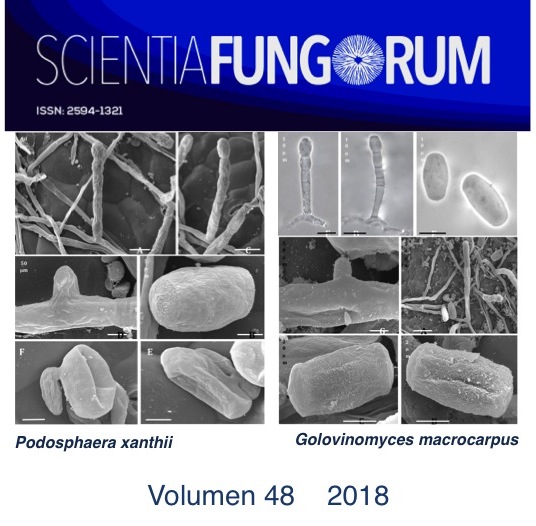Primer reporte de Mortierella elongata como patógeno del cultivo del aguacate en Michoacán, México
DOI:
https://doi.org/10.33885/sf.2018.48.1232Keywords:
patogenicidad, Persea americana, Zygomycota, UruapanAbstract
Antecedentes: Las especies del género Mortierella prosperan usualmente como saprófitas en el suelo y materia orgánica de diversos ecosistemas forestales. Tradicionalmente, se han aislado de los sistemas radicales de diversas especies vegetales. Adicionalmente, investigaciones realizadas en suelo de cultivo de aguacate para lograr la purificación de Pythophthora. cinnamomi indican que Mortierella spp. son hongos contaminantes, sin mencionar su patogenicidad.
Objetivo: Esta investigación tuvo como objetivo identificar la presencia de Mortierella sp. y evaluar su posible patogenicidad en el cultivo del aguacate.
Métodos: Las cepas se aislaron de suelo de huertas ubicadas en los principales municipios productores de aguacate en el estado de Michoacán. Las cepas fueron identificadas y se sometieron a pruebas de patogenicidad con plantas de aguacate de tres meses de edad y con plántulas con seis hojas verdaderas.
Resultados y conclusión:
Downloads
References
Bonito, G., H. Reynolds, M.S. Robeson, J. Nelson, B.P. Hodkinson, G. Tuskan, C.W. Schadt, R. Vilgalys, 2014. Plant host and soil origin influence fungal and bacterial assemblages in the roots of woody plants. Molecular Ecology 23: 3356-3370.
Dann, E., L. Forsberg, A. Cooke, K. Pegg, R. Shivas, Y. Tan, 2011. The “Cylindro” complex of avocado root pathogens. VII World Avocado Congress. Cairns, Australia. Pp. 1-12.
Doyle, J., J.L. Doyle, 1990. Isolation of plant DNA from fresh tissue. Focus 12: 13-15.
Engelbrecht, J., N. Berg, 2013. Expression of defence-related genes against Phytophthora cinnamomi in five avocado rootstocks. South African Journal of Science 109: 1-8.
Davison, E., O. Ribeiro, 1996. Phytophthora diseases worldwide. American Phytopathological Society Press, Minnesota. Pp. 269-280.
FAOSTAT, 2013. Food and Agriculture Organization of the United Nations. Database consulted on January 2017: http://faostat3.fao.org/browse/Q/QC/S
Gams, W., 1977. A key to the species of Mortierella. Persoonia 9: 381-391.
Lumley, T., D. Gignac, R. Currah, 2001. Microfungus communities of white spruce and trembling aspen logs at different stages of decay in disturbed and undisturbed sites in the boreal mixedwood region of Alberta. Canadian Journal of Botany 79: 76-92.
Nagy, L., T. Petkovits, G.M. Kovacs, K. Voigt, C. Vagvolgyi, T. Papp, 2011. Where is the unseen fungal diversity hidden. A study of Mortierella reveals a large contribution of reference collections to the identification of fungal environmental sequences. New Phytologist 191: 789-794.
Ochoa, Y.M., E. Cerna, G. Gallegos, M. Cepeda, J. Landeros, A. Flores, 2015. Variabilidad patogénica de Phytophthora cinnamomi Rands en Persea americana Mill. de Michoacán, México. Ecosistemas y Recursos Agropecuarios 2(5): 211-215.
Pérez, R.M., 2008. Significant Avocado Diseasses Caused by Fungi and oomycetes. The European Journal of Plant Science and Biotechnology 2(1): 1-24.
Ploetz, R., G. Zentmyer, W. Nishijima, k. Rohrbach, H. Ohr, 1994. Compendium of tropical fruit diseases. APS Press, Minnesota.
Rodríguez-Padrón, C., A. Rodríguez, F. Silverio, 2014. Patogenicidad en aguacate de aislados locales de especies de Phytophthora y Phytopythium. Primera descripción de Phytophthora niederhauserii como patógeno del aguacate. XVII Congreso de la Sociedad Española de Fitopatología. Lleida, España. Pp. 130.
SAGARPA, 2015. Secretaria de Agricultura, Ganadería, Desarrollo Social, Pesca y Alimentación. Sistema de Información agroalimentaria y pesquera. Boletín Informativo. http://www.siap.sagarpa.gob.mx. Fecha de consulta abril del 2017.
SIAP, 2014. Sistema de Agroalimentaria y Pesquera. Anuario Estadístico de la Producción Agrícola. http://www.siap.gob.mx. Fecha de consulta abril del 2017.
Tsao, P., S. Guy, 1977. Inhibition of Mortierella and Pythium in a Phytophthora-isolation médium containing Hymexazol. Phytopathology 67: 796-801.
Tsuneo, W., 2010. Pictorial atlas of soil and seed fungi: Morphologies of cultural fungi and key to species. Third edition. CRC Press, Florida.
Uehling, J., A. Gryganskyi, K. Hameed, T. Tschaplinski, P.K. Misztal, S. Wu, A. Desirò, N. Vande Pol, Z. Du, A. Zienkiewicz, K. Zienkiewicz, E. Morin, E. Tisserant, R. Splivallo, M. Hainaut, B. Henrissat, R. Ohm, A. Kuo, J. Yan, A. Lipzen, M. Nolan, K. LaButti, K. Barry, A.H. Goldstein, J. Labbé, C. Schadt, G. Tuskan, I. Grigoriev, F. Martin, R. Vilgalys, G. Bonito, 2017. Comparative genomics of Mortierella elongata and its bacterial endosymbiont Mycoavidus cysteinexigens. Environmental Microbiology 19: 2964-2983.
Van den Berg, N., D.K. Berger, I. Hein, P. Birch, M.J. Wingfield, A. Viljoen, 2007. Tolerance in banana to Fusarium wilt is associated with early up-regulation of cell wall-strengthening genes in the roots. Molecular Plant Pathology 8: 333-341.
Vitale, A., D. Aiello, V. Guarnaccia, G. Perrone, G. Stea, G. Polizzi, 2012. First Report of Root Rot Caused by Ilyonectria (=Neonectria) macrodidyma on avocado (Persea americana). Journal of Phytopathology 160: 156-159.
Yadav, D.R., S.W. Kim, A.G. Babu, M. Adhikari, C. Kim, H.B. Lee, Y.S. Lee, 2014. First report of Mortierella alpina (Mortierellaceae, Zygomycota) isolated from crop field soil in Korea. Mycobiology 42(4): 401-404.
Downloads
Published
How to Cite
Issue
Section
License
Copyright notice
Open access policy
The authors who publish in this journal accept the following conditions:
In accordance with copyright laws, Scientia Fungorum recognizes and respects the authors’ moral rights, as well as the ownership of property rights, which will be transferred to the journal for dissemination in open access. Scientia Fungorum does not charge for submission and processing of articles for publication.
All the texts published by Scientia Fungorum –with no exception– are distributed under a Creative Commons License Attribution-NonCommercial-ShareAlike 4.0 International (CC BY-NC-SA 4.0), which allows third parties to use the publication as long as the work’s authorship and its first publication in this journal are mentioned.
The authors can enter into independent and additional contractual agreements for the nonexclusive distribution of the version of the article published in Scientia Fungorum (for example include it into an institutional repository or publish it in a book) as long as it is clearly and explicitly indicated that the work was published for the first time in Scientia Fungorum.
For all the above, the authors shall send the form of Letter-transfer of Property Rights for the first publication duly filled in and signed by the author(s). This form must be sent as a complementary file.
This work is licensed under a Creative Commons Attribution-NonCommercial-ShareAlike 4.0 International license (CC-By-NC-SA 4.0).



